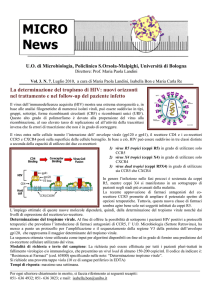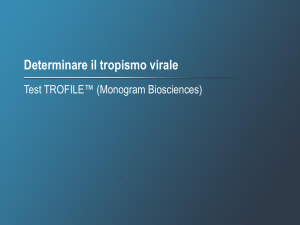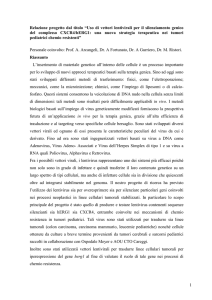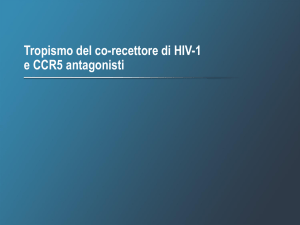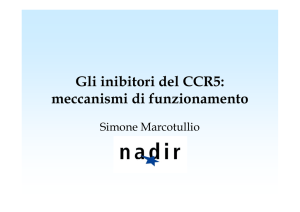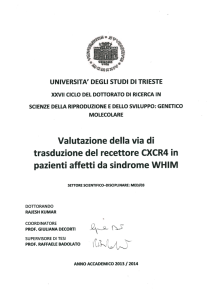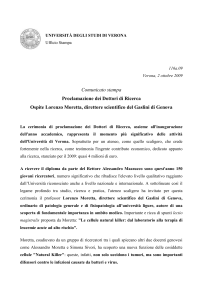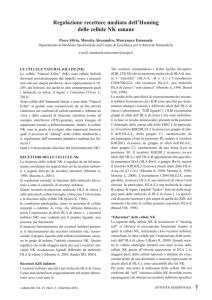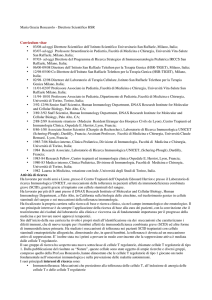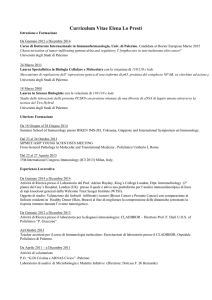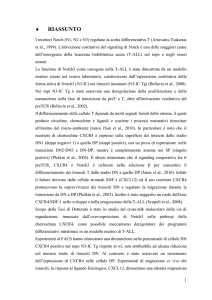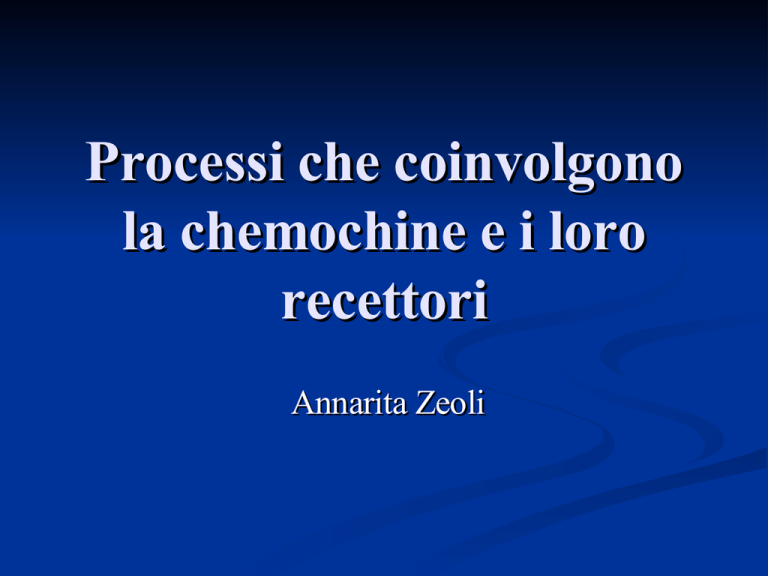
Processi che coinvolgono
la chemochine e i loro
recettori
Annarita Zeoli
Sviluppo nei tessuti
linfoidi primari
Migrazione linfocitaria
Homing linfocitario
Timo
CXCR4/CXCL12
CCR9/ CCL25
CCR4/ CCL17/CCL22
CCR7/ CCL19/CC21
LN, milza, PP
CXCR5/CXCL13
CCR7/CCL19/CCL21
CCR4/CCL22
LN/Milza
CCR7/CCL19/CCL21
CXCR4/CXCL12
Derma
CCR4/CCL17
CCR10/CCL27
Ag
PP
CCR7/CCL19/CCL21
CXCR4/CXCL12
CXCR5/CXCL13
Midollo osseo
CXCR4/CXCL12
CCR9/CCL25
Intestino
CCR9/CCL25
CCR10/CCL28
D.J. Campbell et al., Chemochine in the systemic organization of immunity,Immunological Reviews,195: 58-71,2003
Chemochine omeostatiche:
Sono prodotte in tessuti linfoidi e non linfoidi e
sono coinvolte nel mantenimento fisiologico del
traffico e dell’ homing cellulare
Chemochine infiammatorie:
Sono espresse in tessuti infiammati in seguito a
stimolazione di citochine pro-infiammatorie o
in seguito al contatto con agenti patogeni; sono
coinvolte nel reclutamento di cellule effettrici
come i monociti, granulociti e cellule T
effettrici
CXCL12 e CXCR4 mediano la localizzazione e l’homing delle HSC
HSC (cellule staminali ematopoietiche)
CXCR4
CXCL12
Matrice ossea
Midollo
Sangue
Sviluppo dei linfociti T nel timo
midollare
protimocita
corteccia
timocita
CXCL12+
CCL25 CCR9 CXCR4+
CCR9+
capsula
CCR9+
CCL25+
Cellule
epiteliali
corticali
macrofagi
CCR9+
Cellule
dendritiche
CCR4 +
CCL22 +
T maturi naive
CCR7+
CCR4 -
Cellule
epiteliali
midollari
Sviluppo dei linfociti B
SDF-1
CXCR4
CCL25
CCR9
SANGUE
MIDOLLO OSSEO
HSC
CCR7
cellula Pro-B
Cellula pre-B
CXCR4+/
CXCL12+ CCR9+/CCL25+
CXCR4+/CXCL12+
CXCR4+/CXCL12+
CCR9+/CCL25+
B maturo
CCR7+
CXCR4 -
Homing dei linfociti nella milza, nelle placche di Peyer (PP) e
nel linfonodo (LN)
Homing cellule B
naive(CCR7/CXCR4+)
CXCR5/CXCL13
(mediano la localizzazione follicolare
nella milza, PP e nella regione FDC+
del LN)
Homing cellule T naive (CCR7+)
CCL21 ( HEV) PP
LN
CCL19 (DCs)
CCR6 ( media la
localizzazione nella
regione FDC- )
Rielaborata da Federica Collino
CCR4
CXCR4
CCR7
MIP-1α
MIP-1β
RANTES
CCR1/CCR5
ELC
TARC
MDC
DC-CK1
Vaso afferente
LINFONODO
?
TNF-α
IFN-γ
CXCR1/CCR1/
CCR2/CCR5
DC
follicolo
corteccia
midollare
vena
Vaso efferente
arteria
ZONA T (FDC-)
ZONA B (FDC+)
HEV
T naive
CXCR4+
CCR7+
DC
B
CCR7+
CXCR5+
CXCR4+
T CD4+
CCR7+
CCL22+
CXCL16+
CCR7+
CXCR6+
CCR4+
T memoria
CXCR4+
Tfh
CXCR4+
CXCR5+
TCD4m
CCR1+
CCR4+
CCR6+
CCR7+
CXCR4+
CXCR5
CCR7+
CXCR4+
CCR4+
Tfh
CXCR5+
CCR4+
CXCR4+
Tem
Tem
attivati
CCR1+
CXCR5+
CCR3+
CCR4+
CCR4+
CCR5+
CCR7+
CCR6+
CCR8+
CXCR3+
T effettore
CD8+
B
CCR7
CCL22+
plasmacellule B memoria
CXCR5+
CCR7+
CXCR5
BCA-1
CCR7
SLC,ECL
Differenziazione Th1 e Th2
Patogeni intracellulari
Th1
CCR5+
CXCR3+
CCR7
produzione IFN-γ
IP-10
Mig
MIP-1β
CCL3+
CCL4+
CCL5+
T helper
MDC
TARC
TCA-3
CCL2+
Altri meccanismi
CCR4+
CCR8+
CCR2+
CCR7
Patogeni extracellulari
produzione
IL-4 e IL-13
Th2
S.A. Luther et al., Chemokine as regulators of T cell differentiation, Nature immunology, 2: 102-107,2001
CCR5
4,5
CCL3,
APC
APC
Th
Th1
CCL2
APC
Th
Th2
4
CCL3,
,5
Th1
Attivazione
APC
CCR2
Th
Th
CCL2
Th2
S.A. Luther et al., Chemokine as regulators of T cell differentiation, Nature immunology, 2: 102-107,2001
Homing linfocitario tessuto specifico
Intestino tenue
CCR9
α4β1
IgA
α4β7
CXCR4
microvilli
CCR9
vena
arteria
T
α4β1
cripta
CXCR4
CCL25
MADCAM1
CCR10
Cellule epiteliali
IgA
α4β1
?
α4β7
CXCR4
α4β1
T
CCL28
CXCR4
Epidermide
CCL27
CCR10
CCL17
α4β1
T
CCR4
CLA
CXCR4
CCR10
Midollo osseo e tessuti infiammati
IgA
α4β1
α4β7
CXCR4
CXCL12
CXCR3
IgG
α4β1
CXCR4
CCL9
CCL10
CXCR3
IgG
CXCR4
α4β1
Recettori per le chemochine come target terapeutici
AIDS
Cancro
CXCR6
XCR1
CXCR5
CCR8
costitutivi
CXCR4
CCR6
CXCR1
CCR10
CCR11
CXCR2
inducibili
CCR7
MS
Trapianti
RA
Asma
Nefrite
AIDS
Asma
CX3CR1
CXCR3
CCR5
CCR1
CCR4
CCR3
Asma
CCR2
MS
RA
Asma
Arteriosclerosi
Arteriosclerosi
MS
RA
Trapianti
MS
Trapianti
RA
Asma
Nefrite
A.E.I. Proudfoot, Chemokine receptors: a multifaceted therapeutic targets, Nature rew. Immunology,2: 106-115,2002
Sclerosi multipla
Cellule T
attivate
Cervello
CCR5
Monociti
CCR1
CXCR3
CCL9
CCR5
CCR1
CXCR3
CCR5
CCR1
CCL4
CXCL10
CXCL11
CCR5
CCL3
CCR1
CCL5
A.E.I. Proudfoot, Chemokine receptors: a multifaceted therapeutic targets, Nature rew. Immunology,2: 106-115,2002
Infezione del virus HIV
gp120
CD4
CCR5
CD4
Δ32-CCR5
gp41
La mutazione Δ32-CCR5 impedisce
l’espressione di un recettore funzionale
e, di conseguenza, il legame del virus,
la fusione con la cellula ospite e infine
l’infezione
A.E.I. Proudfoot, Chemokine receptors: a multifaceted therapeutic targets, Nature rew.
Immunology,2: 106-115,2002
Antagonisti dei recettori per le chemochine
Anticorpi :
Ab anti-CXCR3 ( trattamento del rigetto dopo trapianto di cuore)
Ab anti-CXCR4 ( prevenzione metastasi)
Chemochine modificate (delezione N-terminale):
(9-68)-CCL2 ( riduzione sintomi infiammatori in topi MRL-Ipr con artrite spontanea)
Met-CCL5 blocca CCR1 e CCR5 nelle infiammazioni Th1( nefriti, coliti….),
CCR3 nelle infiammazioni Th2
Piccole molecole:
TAK779 inibitore di CCR5 e CCR2
BX471 inibitore selettivo per CCR1
BIBLIOGRAFIA
D. J. Campbell et al, Chemokines in the systemic organization of immunity,
Immunological Reviews, 195: 58-71, 2003
S. A. Luther et al, Chemokines as regulators of T cell differentiation, Nature
immunology, 2: 102-107, 2001
C. R. Mackay, Chemokines: immunology’s high impact factors, Nature
immunology, 2: 95-101, 2001
B. Moser, P. Loetscher, Lymphocyte traffic control by chemokines, Nature
immunology, 2: 123-128, 2001
T. S. Olson, K. Ley, Chemokines and chemokine receptors in leukocyte trafficking,
Am J Physiol Regulatory Integrative Comp Physiol, 283: 7-28, 2002
B. Moser et al, Chemokines: multiple levels of leukocyte migration control, Trends
in immunology, 25: 75-84, 2004
P. J. Nelson et al, Chemokines, chemokine receptors and allograft rejection,
Immunity, 14: 377-386, 2001
A. Zlotnik et al, Chemokines: a new classification system and their role in immunity,
Immunity, 12: 121-127, 2000
A. E. I. Proudfoot, Chemokine receptors: multifaceted therapeutic targets, Nature
Reviews Immunology, 2: 106-115, 2002
E. J. Kunkel et al, Plasma-cell homing, Nature Reviews Immunology, 3: 822-829,
2003
M. Thelen, Dancing to the tune of chemokines, Nature immunology, 2: 129-134,

